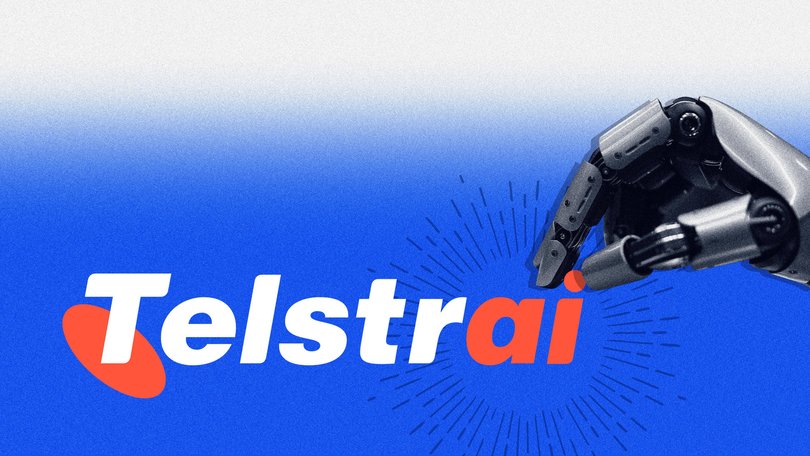AI in business: Telstra and Macquarie’s Artificial Intelligence bet shows where Australian jobs are going

Two major investment announcements by Telstra and Macquarie Bank underscore how quickly the artificial intelligence revolution is set to transform the Australian workforce.
Telstra is set to invest $700 million in AI capabilities across its group over the next seven years, in what would be one of the largest roll-outs of the technology to date.
The investment comes hot on the heels of dramatic slimming down in headcount last year, when Telstra announced 2800 employees - some 10 per cent of the workforce - would be made redundant in a $350m cost cutting drive.
Sign up to The Nightly's newsletters.
Get the first look at the digital newspaper, curated daily stories and breaking headlines delivered to your inbox.
By continuing you agree to our Terms and Privacy Policy.Telstra will create a new joint venture partnership with Accenture aimed at rapidly deploying AI across the business. Accenture would own 60 per cent of the joint venture.
“We’ve made strong progress on our AI goals and already have hundreds of value-driving AI use-cases across the business,” Telstra chief executive Vicki Brad said in a statement.
“From building self-healing, resilient networks, to reinventing experiences for our customers and the way we work, AI will help power an exciting, connected future.”
Sources inside Telstra told The Nightly it was a sign the company was “deadly serious” about trying to reap the benefits of AI, and that the tie-up would allow the telco to leverage Accenture’s expertise in execution.
While Telstra is pursuing a strategy of incorporating AI, Australia’s other blue chip name, Macquarie, is funnelling more into the picks and shovels of the rapidly expanding technology, investing up to $8 billion in a US firm constructing a data centre for AI processing.
Telstra and Macquarie’s investments are a drop in the ocean compared to the estimated $US1 trillion ($1.6 trillion) that will be invested in AI over the coming years, according to Goldman Sachs.
A new report by the World Economic Forum (WEF) estimates that over the next five years almost quarter of the jobs market will be affected worldwide. In a survey of 1000 top global employers, the WEF found that 40 per cent anticipated reducing their workforce where AI can automate tasks.
It is already happening.
Swedish buy now pay later innovator Klarna, which process 2.5 million transactions daily, has reduced its headcount from 4500 to 3500 in a year by using AI to replace those who leave via natural attrition.
“AI can already do all the jobs that we as humans do, it’s just a question of how we apply it and use it,” Klarna CEO Sebastian Siemiatkowski told Bloomberg.
The company says workers are on board with the strategy.
“The total salary cost of Klarna is going to shrink but we’re going to give some of the improvements that efficiency provides by increasing the pace of which the salaries of our employees increases,” he said.
“People in Klarna are just rallying to deploy as much efficiency as they can because it just means it has direct implications on their equity and their cash compensation.”
Presumably the safest people on the Klarna payroll are those who are deploying AI to help eliminate tasks.
The WEF expects that the fastest growing category for jobs will be in AI-related categories like big data and machine learning specialists along with software developers. The future is not so promising for clerical and secretarial workers.
All told, the WEF said, some 60 per cent of all workers will need to upskill over the next five years.
The good news, according a separate paper co-authored by Larry Summers, one of then-President Barack Obama’s most influential economic advisers, is that wide-scale job losses are unlikely to occur.
Mr Summers, et al, have looked at the major technology disruptions since the turn of the last century, including the mechanisation of agriculture, the growth of manufacturing, and the dotcom era.
In each of those transformations, disruptive technologies often replace routine and low-skill jobs but simultaneously create new opportunities, with the change gradual.
While the paper expects the shift to high-skill occupations growing while low and middle-skill jobs decline, the difference this time may be the speed at which dislocation occurs.
In the past, technological change required both hardware investment and deep technological knowledge and training to implement it.
AI, with its scaleability and potential for self-learning, may leapfrog those previous barriers.
For now, however Mr Summers and his co-authors suggest knowledge workers are safe, calling on increased public investment in technical training and reskilling.
“Early research studies suggest that AI tools can replace highly skilled knowledge workers in some job tasks. The demand for good ideas and cogent analysis of complex counterfactual thought experiments (for example, assessing the likely impact of different business decisions, product strategies, etc.) may be nearly unlimited. At least in the near term, AI is more likely to ratchet up firms’ expectations of knowledge workers than it is to replace them,” the paper concluded.
Telstra’s deployment, in theory, would be about assisting employees with better solutions to serve customers, while hopefully reducing the overall cost to serve.
The Commonwealth Bank last year said deployment of AI could result in 90 per cent of customer enquiries being handled by machine agents, and AI had helped get the approval time for business loans down to as little as ten minutes.
“The technology that we have seen over the last six to nine months has the potential to be quite transformational,” CommBank chief executive Matt Comyn said.
The transformation of the jobs market is a key issue for Australian corporations, with 93 per cent of tech leaders wanting to see productivity addressed, according to a survey by the Tech Council of Australia. Labour productivity in Australia has halved compared to the long run average in recent years, going backwards by two per cent in 2023, according to research by the Reserve Bank. US productivity, by comparison, grew by more than two per cent.
With Goldman Sachs suggesting there could be a 15 per cent boost to US labour productivity and GDP growth following widespread adoption of the technology, it’s no surprise that 35 per cent of respondents to the Tech Council survey said using AI to drive operational efficiencies is the greatest opportunity for Australian business.

